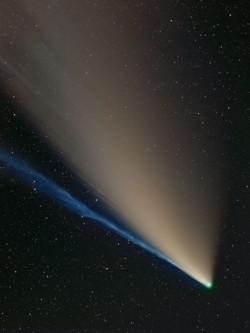Glossary term: 彗发
Description: 当彗星接近太阳时,冰质彗核中的部分固体物质会变成气体。这些气体主要是水蒸气,但也会含有其他化学物质,如一氧化碳、二氧化碳、氨、甲烷和甲醇。这些气体和尘埃粒子一起环绕着彗核,像一团模糊的球形云,这就是彗星大气,或称彗发。随着彗星越来越接近太阳,越来越多的分子在太阳的紫外线光子作用下裂解,加热彗发,使其外部区域膨胀。最终,彗发的外部区域被电离,并形成彗星的离子尾。
Related Terms:
See this term in other languages
Term and definition status: The original definition of this term in English have been approved by a research astronomer and a teacher The translation of this term and its definition is still awaiting approval
The OAE Multilingual Glossary is a project of the IAU Office of Astronomy for Education (OAE) in collaboration with the IAU Office of Astronomy Outreach (OAO). The terms and definitions were chosen, written and reviewed by a collective effort from the OAE, the OAE Centers and Nodes, the OAE National Astronomy Education Coordinators (NAECs) and other volunteers. You can find a full list of credits here. All glossary terms and their definitions are released under a Creative Commons CC BY-4.0 license and should be credited to "IAU OAE".
If you notice a factual or translation error in this glossary term or definition then please get in touch.
Related Media
彗星 C/2020F3 (Neowise),有分开的尘埃尾和离子气体尾,以及发出绿色光芒的彗发,作者 Dietmar Gutermuth,德国
Credit: Dietmar Gutermuth/IAU OAE
License: CC-BY-4.0 Creative Commons 署名 4.0 国际 (CC BY 4.0) icons









